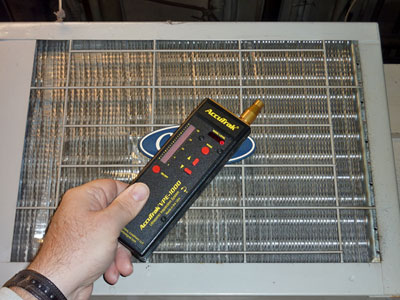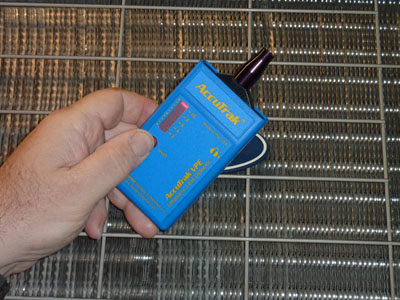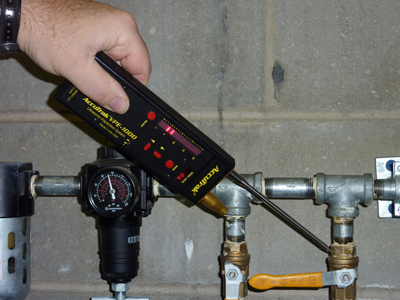Sound Advise
- By Paul Tashian
 Ultrasound is quickly becoming a popular method of Analyzing and troubleshooting problems in HVAC/R systems. Are you listening?
Ultrasound is quickly becoming a popular method of Analyzing and troubleshooting problems in HVAC/R systems. Are you listening?
It seems to be the trend to attempt to reduce the amount of noise generated by heating and cooling systems. Did you know that an HVAC or refrigeration system which appears to be running smoothly and quietly could actually be SCREAMING for help. The problem is that this call for help is taking place in the ultrasonic sound range which is many times higher in frequency then what your human ear can detect. Fortunately, there are instruments available today which will enable you to detect this sound and diagnose problems that otherwise would go undetected. Ultrasonic leak detectors will do just that. These instruments at one time were large, difficult to use, and extremely expensive (over $4000), but recent electronic technologies have made new tools available to our industry which are compact, easy to use and interpret, and affordable to just about every contractor (about $200).
Ultrasonic Leak Detectors have generated a lot of interest in the HVAC/R industry in the past few years. Offering a unique solution to many common problems facing the contractors and service technicians of today. The main reason for their increasing popularity is their versatility. By listening to the ultrasonic sound generated by leaks or other defects in systems, the source of many types of problems can be determined. Although the most common application using ultrasonics is for leak detection, other useful applications also exist.
Gas Leaks
P ressure, Vacuum, or any Type of gas - Ultrasonic Leak Detectors listen for leaks, they do not detect the presence of a gas. For example, you are probably familiar with the sound air makes as it leaks from a tire. The sound that your ear can detect in this situation, is only about a third of the actual spectrum of sound that exists. With very small leaks, most of the sound that is emitted is in the ultrasonic range. This is well above the detection limits of the human ear, but with an ultrasonic leak detector it can be detected and traced to its source. An ultrasonic leak detector will not detect the sound that is within the range of human hearing. This makes the unit effective in relatively noisy environments. Vacuum leaks emit ultrasound, and new refrigerants emit sound as easily as the old. Even nitrogen emits sound when it leaks. This principal of operation makes it possible to detect leaks in windy or contaminated, gas saturated areas. Even while pumped down under vacuum. Newly installed systems can be quickly tested with nitrogen before inducing refrigerant, therefore greatly reducing the risk of leaking ozone depleting tracer gasses.
ressure, Vacuum, or any Type of gas - Ultrasonic Leak Detectors listen for leaks, they do not detect the presence of a gas. For example, you are probably familiar with the sound air makes as it leaks from a tire. The sound that your ear can detect in this situation, is only about a third of the actual spectrum of sound that exists. With very small leaks, most of the sound that is emitted is in the ultrasonic range. This is well above the detection limits of the human ear, but with an ultrasonic leak detector it can be detected and traced to its source. An ultrasonic leak detector will not detect the sound that is within the range of human hearing. This makes the unit effective in relatively noisy environments. Vacuum leaks emit ultrasound, and new refrigerants emit sound as easily as the old. Even nitrogen emits sound when it leaks. This principal of operation makes it possible to detect leaks in windy or contaminated, gas saturated areas. Even while pumped down under vacuum. Newly installed systems can be quickly tested with nitrogen before inducing refrigerant, therefore greatly reducing the risk of leaking ozone depleting tracer gasses.
A good ultrasonic detector will be capable of producing a true reproduction of the leak itself. The rushing sound of the gas should be clearly identifiable when compared to other normal operational sounds. Do not settle for one that "beeps" or "squeals". This will make it difficult to discriminate the actual leak sound from any other background noise. It should also offer a sensitivity adjustment, another important feature if testing in areas with background noise.
Because ultrasonic leak detectors detect sound and not refrigerant, it is impossible to state their sensitivity in terms of ounces per year. The detection capabilities of Ultrasonic detectors are determined by the amount of turbulent gas flow generated by a particular leak. For example, a piece of tubing left to freely exhaust into the atmosphere will not generate ultrasound if the volume of gas through it is not enough for turbulence to take place. Yet the same pressure behind an orifice (leak) size of only .004 of an inch can be heard from many feet away! Although ultrasonic detectors can detect very small leaks, a minimum leak rate of .5 oz/yr. can not be traced with ultrasonics. But remember, at a flow that low, it would take approximately 32 years to loose 1 pound of refrigerant. Also remember, that if another type of detector could detect this low of a leak rate, it was tested to do so in a highly controlled laboratory environment. Not in the windy or possibly contaminated area you will be working in. How often have you had an electronic "sniffer" false alarm at something as simple as a cleaning agent, or even your breath. A good ultrasonic detector will not be affected by wind, stray gasses, or fumes in the test area. Don't misunderstand, the common electronic "sniffers" are certainly very effective in many applications and should not be replaced, but the Ultrasonic Leak Detector is most effective in situations where the "sniffer" is least effective. The ultrasonic detector may not be able to detect .5 oz/yr, but they certainly offer significant advantages which make them a worthwhile addition to any tool box.
Internal System Leakage
 Sound in the ultrasonic range will not only travel through air, but through some solid material as well. Valve housings and steam traps are examples. Some Ultrasonic detectors offer sensitive probes which can detect the ultrasonic sound produced by the turbulent flow of an internal leak. A leaking or faulty steam trap is a source of energy waste and expense and can be detected with this type of equipment. Proper operation of a thermostatic expansion valve can be heard as the refrigerant flows through the valve. Is it flowing or is the power assembly partially defective? Is there wax or ice causing the TXV to work improperly? At what suction pressure does a hot gas by-pass valve start to open and begin to feed hot gas into the low side of the system? These are questions that can be answered with the use of an ultrasonic leak detector.
Sound in the ultrasonic range will not only travel through air, but through some solid material as well. Valve housings and steam traps are examples. Some Ultrasonic detectors offer sensitive probes which can detect the ultrasonic sound produced by the turbulent flow of an internal leak. A leaking or faulty steam trap is a source of energy waste and expense and can be detected with this type of equipment. Proper operation of a thermostatic expansion valve can be heard as the refrigerant flows through the valve. Is it flowing or is the power assembly partially defective? Is there wax or ice causing the TXV to work improperly? At what suction pressure does a hot gas by-pass valve start to open and begin to feed hot gas into the low side of the system? These are questions that can be answered with the use of an ultrasonic leak detector.
If you have never used an ultrasonic detector before, be patient. It will take you a few minutes to understand and interpret the sounds that you are hearing. These units are relatively low in cost and will be well worth the investment with the amount of time that will be saved. Not all sounds in HVAC/R systems are bad. with proper equipment, good testing methods and a good ear, the positive sounds as well as the negative can be heard loud and clear.

